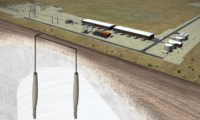A process that works with naturally occurring microbes in soil to reduce its water content is showing promise as a more environmentally sustainable way to stabilize buildings in earthquake-prone zones, says new research presented at an American Geophysical Union meeting earlier this month.
Quake tremors can cause liquefaction of water-logged soils, leaving some buildings susceptible to collapse. Typically, crews use permeation grouting, which involves injecting portland cement into the soil at a building site prior to construction, or flowing water and cement beneath an existing building, to mitigate liquefaction risk.
A study team led by Aisha Faruqi, an industrial ecologist at the University of California-Davis, evaluated the effectiveness of a process called microbially induced desaturation (MID) compared to traditional hazard mitigation techniques. Although other field trials and modeling studies have demonstrated that it is effective in stabilizing soils for up to 20 years, this study was one of the first to examine the environmental benefits of the method.
The process involves providing “food”—in this case, calcium nitrate and calcium acetate—and existing groundwater to help soil bacteria more quickly digest and produce enough gas to de-saturate the soil and prevent liquefaction—more environmentally sustainable because it does not need cement or additional water beyond what is already in the ground, according to Faruqi. Producing cement for permeation grouting requires twice as much water and is double the cost.
“Microbially induced desaturation is a more sustainable alternative to hazard mitigation,” Faruqi says. “It outperforms permeation grouting across various impacts, including global warming potential and cost.”
T. Matthew Evans, a geotechnical engineering professor and an associate dean at Oregon State University, has been studying a similar process, called bio-cementation, which injects urea into the ground to cause a chemical reaction with microbes to precipitate calcium carbonate. This process binds the soil together in a process called microbially induced calcite precipitation.
He notes that bio-cementation and other methods are primarily in the research and development stage. One challenge still to be resolved is the creation of ammonia as a byproduct of the chemical reactions occurring in the soil.
“That either needs to be mitigated, or it needs to be shown to be insignificant enough to not cause environmental problems,” Evans says, noting, however, that there is no question that approaches that take advantage of natural processes rather than pouring more cement into the ground have a better carbon footprint.
“Cement is a very carbon-intensive resource. One of the great advantages of the biological augmentation approaches is we can avoid that,” he says.







